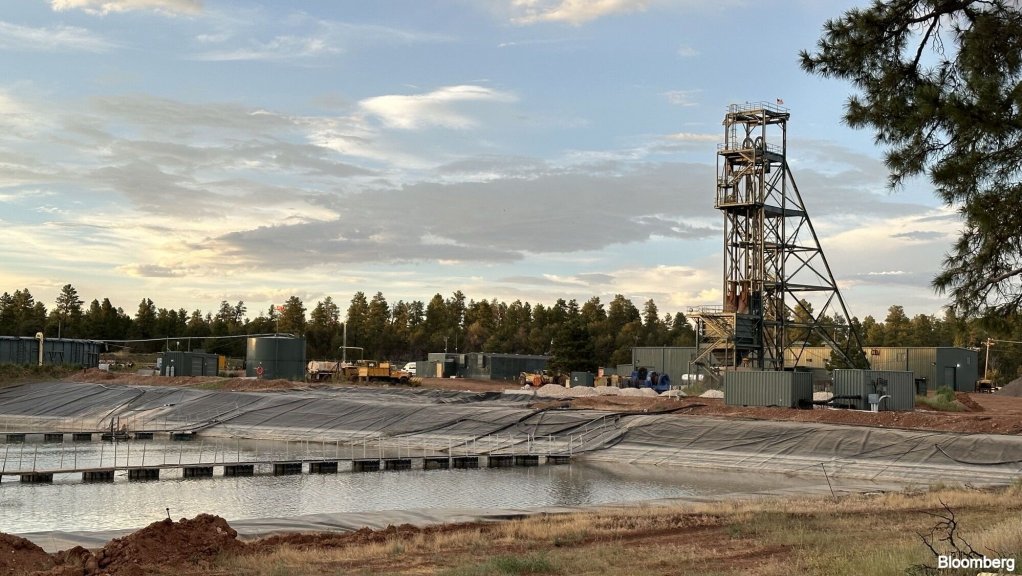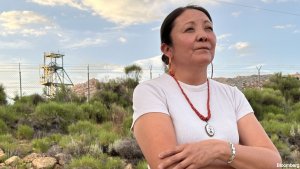Uranium hunters in US West face partial ban, pollution concerns
Five weeks before President Joe Biden announced a historic new ban on new uranium mining around the Grand Canyon, Sarana Riggs approached the barbed-wire fence surrounding an inactive mine in an Arizona national forest, a Geiger counter in her hand.
The Geiger counter didn’t detect any dangerous radiation that day from the Pinyon Plain mine, about two miles from the spot where Biden would sign the monument proclamation. But Riggs wasn’t convinced.
The activist grew up on the Navajo Nation near Tuba City, Arizona, where a uranium mill operated until 1966. It took another 24 years to clean up the site, and yet uranium was still found later in groundwater beneath the town dump.
If uranium prices keep rising, Pinyon Plain’s owners, Energy Fuels, intend to begin mining there and truck the radioactive ore 265 miles through the Navajo Nation, where uranium mining is banned, to Blanding, Utah, where it operates the nation’s only active conventional uranium mill.
At least nine other companies are exploring or planning to prospect for uranium at more than 25 sites across the Colorado Plateau, a region that touches Colorado, New Mexico, Utah and Arizona. Energy Fuels envisions the White Mesa Mill processing most of the uranium.
Mining companies say they’re buoyed by uranium prices that have risen above $55 per pound from around $25 five years ago, a proposed US ban on Russian uranium imports over its attack on Ukraine, and a bullish outlook on nuclear energy amid the climate crisis.
“Uranium is essentially the only option we see to help move away from that reliance on fossil fuels,” said Matthew Schwab, CEO of Kraken Energy, which in July began drilling 20 uranium exploration wells on federal land near Bears Ears National Monument in Utah.
The prospect of a modest comeback for an industry that has been nearly dormant in the US for more than a decade has also rekindled arguments and opinions that span generations — and led to Biden’s announcement Tuesday.
Supporters in Congress say more domestic uranium production will ease the dependence on Russian sources, an energy-related stance the Biden administration has generally encouraged.
Skeptics point to the controversial legacy of uranium mining on the Colorado Plateau, and the radioactive waste left behind. This year, the Environmental Protection Agency proposed adding a long-derelict uranium mining district on the Navajo Nation to its list of Superfund cleanup sites and awarded $65-million to help clean up other abandoned uranium mines on the reservation.
Pinyon Plain, about 15 miles from the rim of the Grand Canyon, is at the center of the national monument that Biden created on Tuesday. Baaj Nwaavjo I’tah Kukveni—Ancestral Footprints of the Grand Canyon National Monument will be three times the size of Los Angeles and protect sites sacred to the Havasupai, Hopi and other tribes mainly by blocking new uranium and other mining in the region.
The monument won’t stop Energy Fuels from digging up uranium, radium and copper at Pinyon Plain, where its right to mine will be preserved. But it could limit the company’s expansion in the area.
For tribal communities, Pinyon Plain is a reminder of the Cold War uranium boom before 1980, when the US was the world’s largest producer, driven by a rush to build nuclear power plants and atomic bombs.
Back then, nearly all the country’s uranium production was centered on the Colorado Plateau, especially on the Navajo Nation. The industry provided thousands of jobs for Indigenous people. The radon exposure brought them sickness and death.
The country’s first cancer treatment center on an Indian reservation opened in Tuba City in 2019. In Riggs’ community, “chemotherapy is an everyday word,” she said. Three of her relatives are battling cancer.
Energy Fuels’ executives say those fears should remain in the past. These days, they face environmental regulations that didn’t exist a half-century ago, they say, and they pay bonds to ensure their mines will be cleaned up.
“I’m saddened that they think we’re harming them, harming the environment, because we’re not. We’re highly regulated,” Energy Fuels Chief Executive Officer Mark Chalmers told Bloomberg Law.
Still, in corporate filings, the company has warned investors that anti-uranium activists are likely to target its business with blockades or lawsuits.
The EPA is watching closely. Federal agencies are still trying to clean up waste at up to 4,000 long abandoned but still-hazardous uranium mine sites across the plateau and Wyoming, including about 500 on the Navajo Nation, according to EPA data.
“We cannot let what has happened in the past perpetuate into the future,” said Cliff Villa, EPA deputy assistant administrator for the Office of Land and Emergency Management.
Not Waiting for Nuclear to Rebound
Solving the climate crisis may depend on low-carbon nuclear energy, but few nuclear power plants have been built since the 1980s because they’re extremely expensive. For about two decades, nuclear has accounted for the same share of the US energy consumption — about 8% — after renewables, coal, oil and natural gas.
Members of Congress, however, including Senator Joe Manchin, a West Virginia Democrat, and Republican Senator John Barrasso of Wyoming have introduced legislation to produce more uranium domestically so the US no longer needs to rely on Russian sources. The measure, if passed, would require the Energy Department to create a nuclear fuel security program that would buy and stockpile uranium produced in the US or in an allied country.
Some miners aren’t waiting because they see the Colorado Plateau brimming with ore. Kraken is exploring in an area a short drive from Canyonlands National Park where minerals are showing what Schwab called “off-scale radioactivity”
“We’re trying to move this one ahead as quickly as possible,” he said.
George Glasier, president and chief executive officer of Western Uranium & Vanadium Corp., said the company is mining and stockpiling uranium ore in western Colorado as it seeks approval for a new mill in Green River, Utah. He hopes that site could begin operating by 2026 or 2027.
“We’re not waiting” for the Russian ban to be approved, Glasier said. “We’re producing now.”
Other uranium companies with active interests in the Four Corners include Thor Energy PLC, EnCore Energy, Atomic Minerals, Consolidated Uranium, Laramide Resources; UVRE, Ltd.; and American Future Fuel Corp. Anfield Energy, Inc., has three prospects in Colorado and Utah, and is studying reopening a long-derelict uranium mill in the region.
Pinyon Plain is in pre-production, or “stand by,” as Energy Fuels awaits higher uranium prices, according to its latest 10-K filing. The company projects it could produce more than 126,000 tons of uranium at $60 per pound.
“It could produce enough uranium to fill a coal train that went from Los Angeles to New York and all the way back again,” Curtis Moore, Energy Fuels’ vice president of marketing, said.
Despite the optimism, the industry will never boom in the region like it once did, Chalmers said.
In 2008, uranium companies produced nearly 3.9 million pounds in the US. By 2022, that had fallen to 194,000 pounds, with production concentrated mainly in Wyoming, South Dakota, Nebraska and Texas, according to a May report by the Energy Information Administration.
Most of the uranium used in US nuclear power plants in 2022 came from Canada, Kazakhstan, Russia, and Uzbekistan, with just 5% sourced domestically, according to EIA data published in June.
Chris Gadomski, head of research focusing on nuclear energy for BloombergNEF, said he’s convinced lawmakers’ and uranium companies’ excitement over US uranium is misplaced — and a bad investment.
“Beware of all these companies we’re talking about, these small second-tier miners are all looking to attract investor interest so they can continue to produce and expand their operations,” Gadomski said.
The uranium demand just isn’t there — and demand from advanced nuclear reactors and small modular reactors isn’t expected to materialize anytime soon, he said. “I wish you saw more of that going on,” Gadomski said.
Making Their Case
For months, anti-uranium activists and tribal leaders had been pressing Biden administration officials with a unified message: Don’t let uranium mining regain its foothold around the Grand Canyon.
The tribes last spring had invited Interior Secretary Deb Haaland to the Grand Canyon to pitch her on creating the new national monument. It would make permanent the 20-year mining moratorium on 917,000 acres of federal land around the Grand Canyon put in place by the Obama administration in 2012 and affirmed by the US Circuit Court of Appeals for the Ninth Circuit in 2017.
“The uranium mining during the Cold War devastated the Navajo people, making many of our people sick from tailings and the runoff that made it into our communities,” Richard Begay, speaking on behalf of Navajo Nation President Buu Nygren, told federal officials during a public meeting last month in Flagstaff, Arizona.
If uranium mining begins at Pinyon Plain or anywhere else around the Grand Canyon, the Havasupai people fear it will poison the aquifer that provides water to Supai, their village at the bottom of the gorge, said Stuart Chavez, a former Havasupai Tribal Council member.
“Our worst fear is that our home will no longer be livable, our water will no longer be there,” Chavez said.
The tribes said the monument would also help repair wounds they incurred when they were forcibly removed from parts of the Grand Canyon when it became a national park more than a century ago.
Ranchers and other opponents told federal officials they want the uranium industry to thrive in their region and that mining won’t affect water quality because uranium is in the water naturally.
“The contamination is not going to change if you ban uranium mining,” said Jim Parks, a member of the Coconino County, Arizona, Farm Bureau and Cattlegrowers Association. “Water has been running down through the uranium deposits all around this Grand Canyon for many millenniums.”
Others said they fear the federal government is trying to take their private land near the proposed monument’s boundaries. Some have long called for all federal land in Arizona to be abolished and turned over to the state — part of a decades-old undercurrent of anti-federal government sentiment in the rural West, but one that’s never gained traction or credibility in Washington.
Land bureau chief Tracy Stone-Manning, who attended the meeting, declined to respond to questions. But the monument designation will affect only public land, no private land will be taken or restricted, the White House said.
In the end, Biden enacted the ban using the Antiquities Act — the same law that President Theodore Roosevelt used to protect the Grand Canyon itself as a national monument in 1908.
Speaking Tuesday near Red Butte, a small mountain near Pinyon Plain sacred to the Havasupai people, Biden said tribes were forced out of the Grand Canyon and he’s declaring the monument to “right the wrongs of the past and conserve this land.”
Biden said his decision kept a promise to Indigenous people who had fought for decades to regain full access to the Grand Canyon, “to protect these lands from mining and development, to clear them from contamination, to preserve their shared legacy for future generations.”
Energy Fuels executives had scoffed at the monument proposal before it was enacted.
“These are tiny little mines,” Moore said in an interview last month. “There is no evidence that these mines have created any environmental contamination, groundwater contamination, or any health issues over the last 50 years.”
But if the ban prohibits the company from exercising what it contends are valid rights to existing claims, Energy Fuels will consider challenging it in court, Moore said.
‘Where Does It Go?’
The Colorado Plateau debate mirrors the dilemma the country faces as it tries to find a more sustainable energy plan. Nuclear energy fueled with domestically produced uranium can be part of a low-carbon energy mix, “but we need to know when that material becomes waste where it needs to go,” Villa, the EPA official, said in an interview.
The process for turning uranium into usable energy is complex. The ore is mined, refined and ground into a powder at a mill. Chemicals are then used to separate the uranium from other minerals, and the end result is a dark substance, called yellowcake, that ultimately is converted into gaseous fuel.
One ton of ore might yield only a few pounds of yellowcake — the rest, still potentially radioactive, is buried or stored at waste sites. Decaying waste eventually can become cancer-causing radon gas.
Federal agencies are still trying to clean up waste at up to 4,000 still-hazardous uranium mine sites across the plateau and Wyoming that miners abandoned after the Cold War, including about 500 on the Navajo Nation, according to EPA data .
“Most of it is sitting right where it is — on tribal land, on the Navajo Nation,” Villa said. “If you’re going to move it, where does it go? That’s not easy.”
In Utah, tribal and environmental activists have protested at the entrance to the White Mesa Mill and say they’re alarmed by the prospect of expanded mining near Bears Ears, about an hour north of the mill.
“The Bears Ears region of SE Utah is one of the most wild, scenic, and culturally rich in the nation. It is not the appropriate place for uranium development of any kind,” Landon Newell, staff attorney for the Southern Utah Wilderness Alliance, said in an email.
More intense concern comes from the other direction, from those who live along the six-hour route trucks would use to haul uranium ore between Pinyon Plain and the White Mesa Mill.
“For what?” asked Riggs, the anti-mining activist who grew up in Tuba City. “For economic growth? For somebody to get rich out there? At whose expense?”
The acrimony is particularly focused on the mill itself. Members of the nearby Ute Mountain Ute tribal community of White Mesa have long worried that Energy Fuels’ uranium milling and storage is already contaminating their air and groundwater.
Tribal members have observed “overwhelming smells in the air,” and “deformed animals” in the area, and don’t believe that the mill is safe, Scott Clow, environmental programs director for the Ute Mountain Ute Tribe, told the Nuclear Regulatory Commission in 2021 comments .
Moore, Energy Fuels’ vice president, said the tribe’s claims are unprovable, anecdotal and unsupported by evidence. In an email he called Clow’s claims “fearmongering and smears” so outrageous that Energy Fuels has considered suing him for defamation.
He pointed to the findings from a federal investigation that the Ute requested in 2019. Four years after that petition, the Agency for Toxic Substances and Disease Registry, part of the Department of Health and Human Services, reported in June that anyone consuming the drinking water at White Mesa won’t be harmed by radiological contaminants, and that air pollution from the mill is below the agency’s minimal risk level for radiation. The report didn’t evaluate whether the mill was polluting groundwater.
Clow called the report “good news” and noted that tribal members are avoiding springs fed by groundwater. He also said history has taught his community not to accept at face value any claims about uranium mining.
“You can’t ignore the 500-plus sites just on Navajo Nation that are still contaminated uranium sites,” he said.
More stories like this are available on [bloomberg.com](https://www.bloomberg.com)
©2023 Bloomberg L.P.
keywords: 0045018D, AEC@CN, AMPS@CN, EFR@CN, THR@LN, UUSA@CN, UVA@AU, WUC@CN, ALLTOP, BASIC, BUSINESS, CLIMATE, CMD, COS, EXE, GEN, GENTOP, GOV, HEA, INDUSTRIES, LAW, METMNG, NORTHAM, NRG, TOP, US, UTI, WORLD, WWTOP, WWTOPAM
Canonical Link:https://www.bloomberg.com/news/features/2023-08-10/grand-canyon-monument-won-t-stop-hunt-for-more-us-uranium
©2022 Bloomberg L.P. All Rights Reserved
Comments
Press Office
Announcements
What's On
Subscribe to improve your user experience...
Option 1 (equivalent of R125 a month):
Receive a weekly copy of Creamer Media's Engineering News & Mining Weekly magazine
(print copy for those in South Africa and e-magazine for those outside of South Africa)
Receive daily email newsletters
Access to full search results
Access archive of magazine back copies
Access to Projects in Progress
Access to ONE Research Report of your choice in PDF format
Option 2 (equivalent of R375 a month):
All benefits from Option 1
PLUS
Access to Creamer Media's Research Channel Africa for ALL Research Reports, in PDF format, on various industrial and mining sectors
including Electricity; Water; Energy Transition; Hydrogen; Roads, Rail and Ports; Coal; Gold; Platinum; Battery Metals; etc.
Already a subscriber?
Forgotten your password?
Receive weekly copy of Creamer Media's Engineering News & Mining Weekly magazine (print copy for those in South Africa and e-magazine for those outside of South Africa)
➕
Recieve daily email newsletters
➕
Access to full search results
➕
Access archive of magazine back copies
➕
Access to Projects in Progress
➕
Access to ONE Research Report of your choice in PDF format
RESEARCH CHANNEL AFRICA
R4500 (equivalent of R375 a month)
SUBSCRIBEAll benefits from Option 1
➕
Access to Creamer Media's Research Channel Africa for ALL Research Reports on various industrial and mining sectors, in PDF format, including on:
Electricity
➕
Water
➕
Energy Transition
➕
Hydrogen
➕
Roads, Rail and Ports
➕
Coal
➕
Gold
➕
Platinum
➕
Battery Metals
➕
etc.
Receive all benefits from Option 1 or Option 2 delivered to numerous people at your company
➕
Multiple User names and Passwords for simultaneous log-ins
➕
Intranet integration access to all in your organisation






















